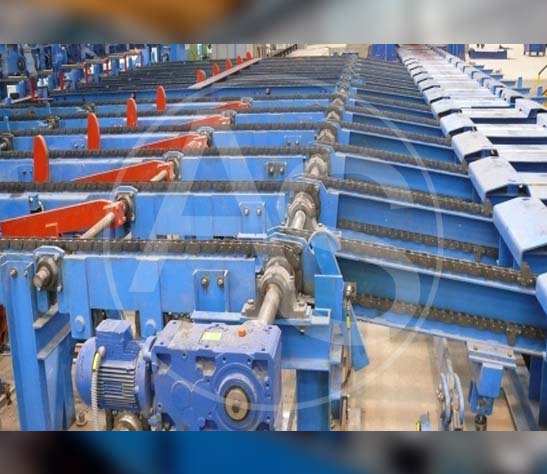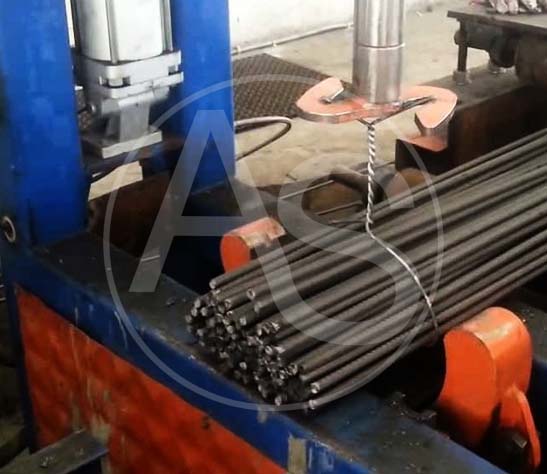
Bar Handling Area
Finishing equipment includes the automatic stacking, bending, bundling, binding weighing and lebeling of rolled products.
Material Handling
Chain Transfer
First Chain Layer Transfer
Single section of driven chain modules. Type lift-able to transfer the cut bars. Chains are heavy-duty type and slide on steel guides. Each transfer section is driven by means of electric motors and gear reducers. The transmission shafts are mounted on roller bearings.Frame is made of steel section. Manual grease lubrications used double sequence type, will discharge the bars from cold shear run out table to the second chain section. A chain lifting device lifts the chain, normally positioned under top of the cold shear run out rollers,above the roller table and transmits to the chain transfer.
Second Chain Transfer
This chain transfer is located downstream the first chain transfer, its function is to feed the bar to the counting system with layers of bars. Chains are heavy-duty type and slide on steel guides. Each transfer section is driven by means of electric motors and gear reducers. The transmission shafts are mounted on roller bearings which in turn rest on the steel frames.

Third Chain Transfer Section
Located downstream the bar counting system, its function is to transfer counted bars to the bundle forming station. Chains are heavy-duty type and slide on steel guides. Each transfer section is driven by means of electric motors and gear reducers. The transmission shafts are mounted on roller bearings, frame in steel section. All bearings and pivoting points are grease lubricated.
Bar Counter
Located aside the second chain transfer, its function is to automatically and accurately count the bars before bundle formation. Welded steel structure support the bar counting system. A chain moving at speed higher than the one of the chain transfer creates a gap between two sets of bars allowing bar counting through photocell and also through rotation of the counter. A set of separating fingers operating by pneumatic cylinders will separate the last bar counted from the counting screw. The separating fingers separate two sets of bars, one after the other, in cascade sequence

Bundling Station
Welded steel structure. The counted bars from the bar counter are transferred to a collecting cradle for sub-bundle tying machines or for master tying machine. There are a total of 4 sub-bundle tying machines. The sub-bundles are transferred to the discharge roller table with the help of transfer arms until a full master bundle is obtained. A set of collecting arms will receive and contain bars. Manual grease lubrication of bearing.
Bar Collection Systems
High Speed Bar Collection System (Rotating Drum):
In case of higher capacity mills, the finishing speed of the bar is very high, the twin channel is replaced with a high-speed bar collection system, which we name as rotating drum; a drop wall system or a rotating twin channel, which can receive more than one finished bar concurrently.
Short Bar Collection System
Layers of bars are stopped over a roller table, a magnet stops the ends of full length bars, while the rolls extract the short bars from the layer. Short bars proceed on the roller table outside the chain conveyor, up to an end stopper. Scrap bars are collected in cradles for manual binding and removal. Roller in steel tube mounted on roller bearing support. Each roller is individually driven by means of gear motor. Frame in steel sections.
